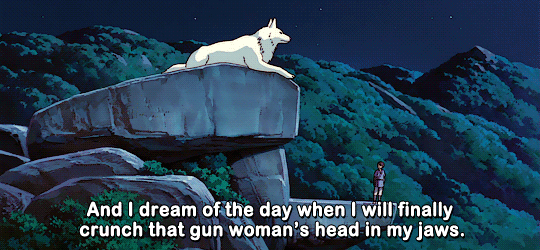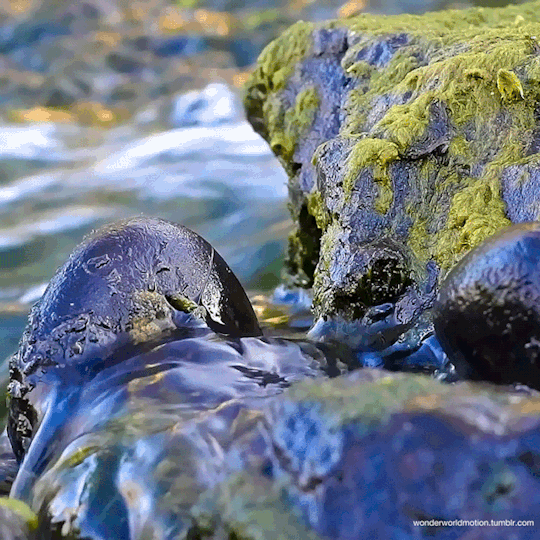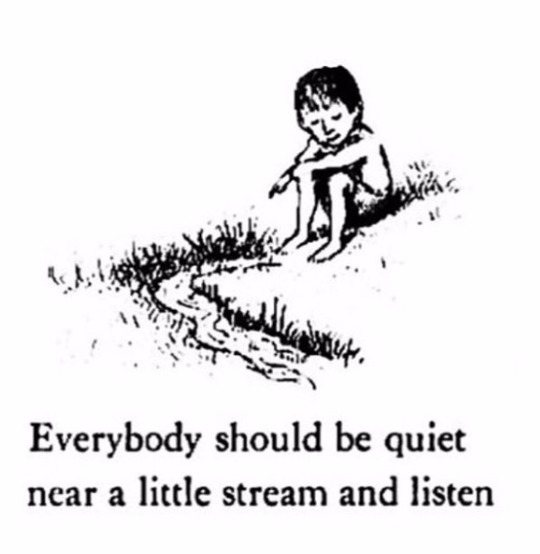An aspiring solitary Druid. In love with trees, the sun, and my local watershed. My self imposed novice year ends next Lughnasadh. Check #about for more.
Don't wanna be here? Send us removal request.
Text
I get a lot of questions from people who want to teach their kids environmental stewardship and my advice is to get them passionate about the nature around them. Distant wildlife is exciting and cool! It can teach them to appreciate, but I find it rarely teaches them to value.
Value and respect come from recognizing your place in nature and your ability to both help and hurt.
Go outside and just move some rocks and let them hold some worms. Let them get muddy. If they squash a bug, ask them why. Tell them the bugs live here too.
This sounds silly, but it’s tried and true. Each time I’ve seen a kid smash a bug, I say “why did you feel that bug wasn’t allowed to be alive?” Never in an accusing tone, never judgmental. Ask them gently, honestly. They might be dismissive and bashful at first, but if you ask them again, if you say “I like bugs, and I think it’s good that they are alive,” they start to think. You can see it happen. You can see them begin to consider life they’ve probably been told before doesn’t mater.
Tell them what you like about bugs. If you’re afraid of bugs, tell them that too. tell them “I find them a little scary, but this is why they’re still good.” Tell them they don’t have to like something for it to have value. Tell them even the things they don’t like have value.
Every time a child says they’re afraid of bugs, or dirt, we go outside, and I find a worm (most people react best to them because they don’t have a bunch of little legs), and I hold it and tell them some simple little facts. I ask them if they want to hold it. They almost always do. It’s okay if they don’t want to. Never force the interaction. It’s vital to form positive experiences and associations.
I wipe some mud on my hands. I ask them if they want some mud on their hands. If they do, I give them some mud. I tell them what worms are doing down their in the ground, which anyone can learn on google to share.
We move rocks and find beetles and spiders. They’re delicate, so we don’t pick them up. We watch them. I ask them what they imagine beetles think about all day, and they always make me laugh with their ideas. I tell them “maybe, maybe that’s what beetles think about.” Let them imagine.
Look up the birds where you live. Yes, even the “boring” ones like pigeons and sparrows. Talk about what the eat, where they go at night to sleep. Ask them where they think birds sleep. In beds like us? They’ll usually tell you no, in trees! Kids want to teach as much as they want to learn.
We talk about grass and trees. We talk about what makes the world alive. Their young minds change and make new decisions about how they want to exist in the world.
One day, if all goes well, value and respect grow into a sense of responsibility and obligation.
Do this again and again.
#there is no other way#there is nothing more important#how do i say that if we stop doing this#and teach them to hate being dirty and sweaty and scared of bugs#that we are directly contributing to the death of our species
51K notes
·
View notes
Text

I hope everyone had a nice solstice! I spent the time visiting home and really got to enjoy a return to my roots while simultaneously exploring in new ways magically.
As the sun grows day by day I hope I can continue to grow on this path. And I hope the changing of the seasons brings you all whatever you're seeking for yourselves.
16 notes
·
View notes
Photo


Throwin’ the Bones
Of the divinatory techniques with which I am familiar, bones are my personal favorite. Yes, they have that very witchy vibe – but it’s more than that; the bones are honest. They don’t sugar coat, and while they have to be interpreted, once you know how to read them – there’s little room for interpretation. They are very direct and are much better suited to answering yes or no questions than tarot. With a little imaginative methodology, there few questions the bones can’t answer. And even fewer they won’t answer (as tarot cards can be known to do). A few examples of things I think the bones are better at answering than tarot: questions involving time, questions regarding health, sickness and maledictions; they present a broader grasp to any given situation – incorporating things outside of the question presented and how these things relate to the question or the reading, showing the interconnectedness of life – and how these things all relate back.
Our countless cultures have countless methods for collecting and reading the Bones – and I can only rightly attest to my own methodology: one in which the Bones need not necessarily consist solely of bones, but a collection of gathered trinkets and curios, all with their own meaning, their own story and their own energy. My collection consists of: bones (bare and painted), coins, stones, shells, jewelry, twigs, buttons, animal teeth and other squabbles. The only rule I implement is that the item can be easily gathered and (safely) tossed without breakage or injury (save your razor-blades and glass shards for witches’ bottles!).
Collecting the Bones and Bobbles
Most any small bones will do, though its recommended that you use bones that haven’t been cooked, as cooked bones have a tendency to get very brittle – especially in the case of chicken, which is quite common. In my collection I have a number of different animal bones: most are chicken, but I also have some raccoon and possum bones, as well as teeth and claws. I built a “base” of bones, but am continuously adding or replacing as I see fit.
A short list of “Bones” I like to include – most of which serve as my “base” bones:
Self Bone – used for the reader
Other Bone – used to represent another person or the person you are reading
Magic Bone – represents the need for or use of magic
“Evil” Bone – malicious or hateful acts, disadvantageous behavior
Love Bone – represents romantic love
Male Bone – represents male fertility, masculinity, sexuality or a man
Female Bone – represents female fertility, femininity, sexuality or a woman
Health Bone – represents physical or mental health
Wealth Bone – represents financial standing or monetary issues
Family Bone – represents familial connections or a family member
Fate Bone – represents destiny and your lifepath (I use a shell for this: open side up means an event can be altered, destiny is not set in stone; open side down, this path must be walked – prepare in lieu of fighting)
“Key” Bone – (I actually use a small key) which represents the key to any given situation, the remedy or problem at hand and its cause
This list is by no means comprehensive and I have many more bones in my collection with more menial meanings. This is simply a small list of options to be added to and adapted by whosoever casts the bones.
Reading the Bones
There is no right or wrong way to read the bones, there is simply your way and their way. Below I will dictate how it is that I do a general reading – again, this is just an example of one way, take and adapt to fit your own unique style or tradition!
Begin by collecting your bones into your hand. I keep mine in a leather pouch, but don’t like to toss them directly from the bag as it doesn’t allow for much control – i.e. the bones fall out either in a massive, unreadable pile or they fly out in such a scattered way nothing is close enough to read. Throwing them from the hand allows for a rather contained casting, and one that can be read easily. I do not include the Self or Other bone, instead, the Self Bone is placed before the caster and the Other Bones is placed either in front of the person you’re reading for or simply in the middle of the casting area. When reading for yourself, place the Self Bone in the center and discard the Other Bone.
Throw the Bones. This can be done on a square of cloth on which a circle (or any number of complex shapes) has been drawn or simply upon a flat table. If throwing in a circle, discard all bones that fall outside of it. These bones are null for the reading, though they can also be read as “far from the person’s mind/current situation.”
Interpret the Bones. This is done by noting the location and connection of the bones present. For instance, note the Love Bones proximity to the Other Bones and the Male Bone. This could be interpreted as being the male love of the querent – but if the “Evil” bones is introduced, this could symbol ulterior motives or a hostile or explosive relationship. Read based on both their proximity to the Other Bone – the closer, the higher priority the matter is – and their relation to one another. It’s very much like investigating a big puzzle, putting it together piece by piece to form a comprehensive understanding of their life or situation. Also not their relation based on the third dimension: x bone seems to be overlapping y bone – is the x issue eclipsing an underlying problem or truth represented by y? It depends. Only through practice will you find clarity.
Convey the message. I always like to spend a few moments making a variety of “hmm” noises when reading for others – it builds up their anticipation. Or you can throw in the occasional gasp or snarky smirk. Their responses are usually hilarious – even more so when yours are genuine! If you are reading on your own, it may be a good idea to sketch out a general map of the readings as opposed to taking a picture as often bones overlie others, which makes for a rather misleading photo representation. You might also find jotting down notes rewarding, especially in synthesizing a cohesive read.
Once you’ve garnered all the information you can from that particular toss, feel free to specify: take the bone/situation you wish to examine and toss the rest again over it/them, reading the others through that particular lens. I.E. Who is this person mentioned? What are their qualities? What is the nature of this love? What magic is being referenced here? Follow that rabbit hole as far as you wish, building your understanding.
Do not be afraid to adjust your style! Want to narrow down a time frame? Make a sort of timeline with the bones. Wish to determine the source of an ailment? Shape the bones into the form of a body. I find the bones allow for far more creativity and ingenuity than cards. And above all – TRUST YOUR GUT.
Photos: These are photos of my “base” bones when I first started reading; since then they have probably doubled (if not tripled) in number and do not incorporate my other animal bones, claws or teeth.
16K notes
·
View notes
Text

The light has been found and brought to the hearth; the flame has been kindled in joy and in love. Come the sun, out from the dark: find your way home to the world once more!
51 notes
·
View notes
Text
Hildegard von Bingen didn't write Physica and Causae et Curae for you to say medieval people were anti-science because of religion.
974 notes
·
View notes
Text
You know, advancing in your craft gets harder to blog about, because like… I can try to sound all fancy and aesthetic and say “I’m sitting here contemplating new schools of magic while crafting enchantments”, which is true, but it sounds less fancy when I say “I’m watching Critical Role and thinking really hard about Pop Culture magic while I crochet miniature baskets for a fairy house”.
1K notes
·
View notes
Photo



Princess Mononoke (1997), dir. Hayao Miyazaki
20K notes
·
View notes
Text
Yule Time Rebirth Ornaments
What you'll need:
•Strips of paper
•Herbs, flowers, crystals
•Clear ornaments
•Anything else you want to add
To bless your and those around you's new year: write the individuals name on the slip of paper and put it into the ornament. Add in herbs, flowers, and crystals that correspond with what you'd like for them in the new year! Such as rosemary and tourmaline for protection. Say a blessing while hanging it up on your tree.
For a specific well wish do all of the above and add in an extra slip of paper. This extra slip of paper will have the well wish you provide; such as "less anxiety" or "a year of opportunity".
693 notes
·
View notes
Text



Gingerbread Stonehenge that I made over Yule. Fondly known as the GingerHenge.
4K notes
·
View notes










